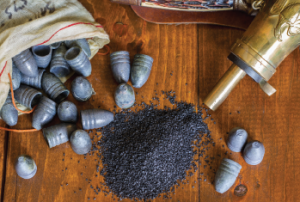
Matt Cuda / shutterstock.com
Black powder was initially developed in 9th century China, by Taoists searching for the philosopher’s stone, which fans of Harry Potter will remember is the talisman that grants eternal life. The Chinese name for black powder literally translates as fire medicine. The chemical composition of black powder was first recorded in China during the 11th century and prominently featured saltpeter, or potassium nitrate, which was a key component of many medicinal compounds at that time.1
Soon after the composition of black powder was recorded, its raison d’être became apparent: You could set it on fire. Black powder is called a low explosive, because when it ignites, it decomposes slowly, and it creates a propulsive force at subsonic speeds, enough to propel a bullet without rupturing the barrel of a gun. And so the modern era of warfare was born.
But that’s not the story I want to tell.
Evolution
The same features that made black powder, also known as gunpowder, effective in munitions also made it ineffective in a field far more lucrative than warfare—mining. Its low explosive force made it ineffectual at rending rock face so miners could reach the valuable minerals that lay beneath. Gunpowder was a low explosive. What the miners needed was a high explosive.
Miners would have to wait until 1847, when an Italian chemist named Ascanio Sobrero wrote a monograph on “detonating compounds” that could be produced by combining nitric acid with a number of substances, including sugar, dextrin, lactose and glycerine. Dr. Sobrero wrote, “The results that I have just obtained prove that glycerine is capable of giving, when mixed with nitric and sulfuric acids, a substance similar to gun cotton” or nitrocellulose, which was the most powerful explosive at that time.2
Dr. Sobrero actually discouraged the commercial use of nitroglycerin. In his subsequent papers, he described characterizing the properties of nitroglycerin by using just a few drops, because the compound was so unstable.3 The problem was that commercial applications, like mining, required crates—not just drops—of nitroglycerin to be transported over long distances.
The results were predictable. In 1867, the state of California banned the transport of liquid nitroglycerin.4 Other states soon followed, and eventually heavy restrictions on the transportation of nitroglycerin became commonplace.
The Accidental Prize
This was a problem for a munitions company that had gradually morphed into a company specializing in the production of nitroglycerin for excavation and mining. Its profits in danger, Alfred Nobel & Company focused on developing a safer, more stable version of nitroglycerin. Mr. Nobel was the son of an inventor, and perhaps it is not surprising he figured out that by combining nitroglycerin with the diatomaceous earth that surrounded his factory in Hamburg, he was able to stabilize dynamite for transport.5 When combined with his other invention, the blasting cap, which allowed for remote detonation, it was the perfect explosive.
But that’s not the story I want to tell, either.
There is an expression that, “if you build a better mousetrap, the world will beat a path to your door.” Mr. Nobel had succeeded in building a better mousetrap. His brilliance may not have been in the invention of dynamite, however, but may have been in his aggressive defense of his patent for dynamite. If you wanted this particular mousetrap, you would have to buy it from him.
Gradually, this led to the accumulation of an enormous amount of wealth under a single person.
How did we get from there to the Nobel Prize? It may have been an accident.
In 1888, Alfred’s brother, Ludvig Nobel, died. A French journalist, thinking it was Alfred who had passed on, wrote, “le marchand de la mort est mort”—or “the merchant of death is dead.”6 Although he had not yet died, the description was otherwise accurate. Alfred Nobel continued to make large amounts of money from the sale of munitions, in addition to the sale of explosives. This weighed on him heavily, and it is said this headline, along with his brother’s passing and his own approaching mortality, made him think carefully about the legacy he wanted to leave behind.
It also may have been a bit of luck. Upon Alfred Nobel’s death, he left the majority of his wealth to the creation of a series of prizes to be awarded by the Royal Swedish Academy of Sciences, the Karolinska Institute, the Swedish Academy and the Parliament of Norway. But there were a few problems:
“The will of Alfred Nobel came as a complete surprise; he had discussed it with no one before his death. It was handwritten on a sheet of paper, with notes scribbled in the margin, and had never been reviewed by a lawyer, since Nobel distrusted lawyers. … They faced several problems:

